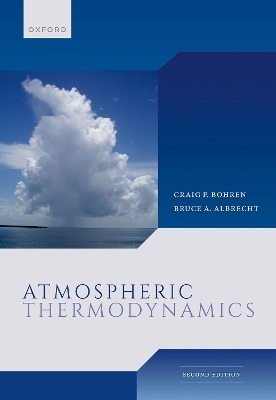
Atmospheric Thermodynamics
Oxford University Press (Verlag)
978-0-19-887270-2 (ISBN)
Atmospheric Thermodynamics provides a comprehensive treatment of a subject that can often be intimidating. The text analyses real-life problems and applications of the subject, alongside of guiding the reader through the fundamental basics and covering the first and second laws and the ideal gas law, followed by an emphasis on moist processes in Earth's atmosphere. Water in all its phases is a critical component of weather and the Earth's climate system.
With user-friendly chapters that include energy conservation and water and its transformations, the authors write with a willingness to expose assumptions and approximations usually absent in other textbooks. History is woven into the text to provide a context for the time evolution of thermodynamics and its place in atmospheric science and demonstrating how physical reasoning leads to correct explanations of everyday phenomena. Many of the experiments described were done using inexpensive instruments to take advantage of the earth's atmosphere as a freely accessible thermodynamics library.
This second edition provides updated treatments of atmospheric measurements and substantially expanded sections that include atmospheric applications of the first and second laws and energy exchange between humans and their atmospheric environment. With 400+ thought provoking problems and 350 references with annotated notes and further reading suggestions, this second edition provides a basic understanding of the fundamentals of this subject while still being a comprehensive reference guide for those working in the field of atmospheric and environmental sciences.
Craig Bohren's degrees are in mechanical engineering, nuclear engineering, and physics. He was the first Distinguished Professor of Meteorology at Penn State. Within two years after arriving he received the Matthew J. and Anne C. Wilson Outstanding Teaching Award of the College of Earth and Mineral Sciences. He wrote two popular level books, Clouds in a Glass of Beer , which received the first Louis J. Battan Award for Authors, American Meteorological Society (1989) and What Light Through Yonder Window Breaks? His 1983 book with Donald Huffman, Absorption and Scattering of Light by Small Particles has been cited more than 30,000 times. He retired in 2000 but did not stop working. Fundamentals of Atmospheric Radiation (with Eugene Clothiaux) was published in 2006 and since 2012 he has been the book review editor for American Journal of Physics. Bruce Albrecht received his Ph.D. from the Department of Atmospheric Sciences at Colorado State University. He was a teacher and researcher in the Department of Meteorology at Penn State University (1977-1995) and in the Rosenstiel School of Marine and Atmospheric Science at the University of Miami (1996-2013). His key scientific contributions include work on the trade-wind boundary layer, marine stratocumulus clouds, cloud-aerosol-precipitation interactions, and cloud radar observations. His 1989 Science paper Aerosols, Cloud Microphysics, and Fractional Cloudiness has received over 4000 citations. He was the recipient of the American Meteorological Society Teaching Excellence Award in 2013 and was an editor of the Monthly Weather Review (1985-1990) and the Journal of Atmospheric Sciences (2008-2011).
1 INTRODUCTION: CONSERVATION OF ENERGY
1.1: Thermodynamics: A Science of Measurable Quantities
1.2: Conservation of Energy in Mechanics
1.3: Conservation of Energy: A System of Point Molecules
1.4: A Few Examples of Energy Conservation
1.5: Kinetic Energy Exchanges in Molecular Collisions
1.6: Working and Heating
1.7: Some Necessary Thermodynamic Concepts and Jargon
1.8: Thermodynamic Internal Energy and the First Law
2 IDEAL GAS LAW: PRESSURE AND ABSOLUTE TEMPERATURE
2.1: Gas Pressure and Absolute Temperature: What Are They and What Are They Not?
2.2: Pressure Decrease with Height: Continuum Approach
2.3: Pressure Decrease with Height: Molecular Interpretation
2.4: The Maxwell-Boltzmann Distribution of Molecular Speeds
2.5: Intermolecular Separation, Mean Free Path, and Collision Rate
2.6: Is the Pressure Gradient a Fundamental Force of Nature?
2.7: Surface Pressure and Weight of the Atmosphere
2.8: The Atmosphere Is a Mixture of Gases: Dalton's Law
3 SPECIFIC HEATS AND ENTHALPY: ADIABATIC PROCESSES
3.1: A Critique of the Mathematics of Thermodynamics
3.2: Specific Heats and Enthalpy
3.3: Adiabatic Processes: Poisson's Relations
3.4: (Dry) Adiabatic Processes in the Atmosphere
3.5: Stability and Buoyancy
3.6: Specific Heats of Gas Molecules
3.7: Heat Capacities of Mixtures of Gases
3.8: Atmospheric Applications of the First Law
3.9: Chemical Reactions and Temperature Changes
3.10: Residence Time of the Internal Kinetic Energy of Earth's Atmosphere
4 ENTROPY
4.1: Entropy of an Ideal Gas
4.2: Entropy Changes of Liquids and Isotropic Solids
4.3: Atmospheric Applications of the Second Law
5 WATER AND ITS TRANSFORMATIONS
5.1: Evaporation and Condensation of Water Vapor
5.2: Measures of Water Vapor in Air
5.3: The Clausius-Clapeyron Equation
5.4: van der Waals Equation of State
5.5: Phase Diagrams: Liquid-Vapor; Liquid-Solid-Vapor; Triple Point
5.6: Free Energy
5.7: Effect of Air Pressure on Saturation Vapor Pressure
5.8: Lowering of Vapor Pressure by Dissolution
5.9: Air in Water: Henry's Law
5.10: Size Dependence of Vapor Pressure: Water Droplets, Solution Droplets, and Bubbles
6 MOIST AIR AND CLOUDS
6.1: Precipitable Water in the Atmosphere
6.2: Lapse Rate of the Dew Point: Level of Cloud Formation
6.3: Density of Moist Air: Virtual Temperature
6.4: Wet-Bulb Temperature
6.5: Lapse Rate for Isentropic Ascent of a Saturated Parcel
6.6: Thermodynamic Diagrams
6.7: Stability and Cloud Formation
6.8: Mixing Clouds
6.9: Cloud Formation on Ascent and Descent
7 ENERGY, MOMENTUM, AND MASS TRANSFER
7.1: Energy Transfer by Thermal Conduction
7.2: Momentum Transfer: Viscosity
7.3: Mass Transfer: Diffusion
Bibliography
Index
Free
| Erscheinungsdatum | 12.05.2023 |
|---|---|
| Zusatzinfo | 87 line drawings |
| Verlagsort | Oxford |
| Sprache | englisch |
| Maße | 177 x 253 mm |
| Gewicht | 1342 g |
| Themenwelt | Naturwissenschaften ► Geowissenschaften ► Geologie |
| Naturwissenschaften ► Geowissenschaften ► Meteorologie / Klimatologie | |
| Naturwissenschaften ► Physik / Astronomie ► Angewandte Physik | |
| Naturwissenschaften ► Physik / Astronomie ► Thermodynamik | |
| ISBN-10 | 0-19-887270-4 / 0198872704 |
| ISBN-13 | 978-0-19-887270-2 / 9780198872702 |
| Zustand | Neuware |
| Haben Sie eine Frage zum Produkt? |
aus dem Bereich


